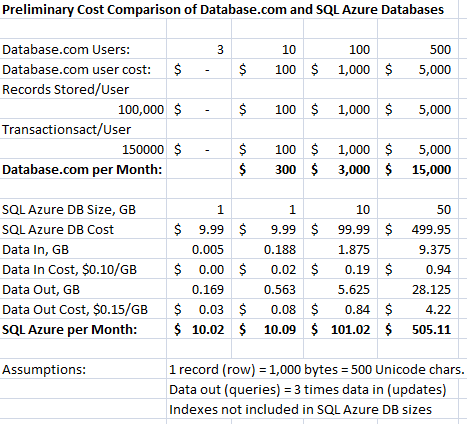Microsoft readies public SQL Azure Reporting test build, as Salesforce launches a cloud database

Microsoft is allowing testers to register, as of December 7, for a public Community Technology Preview (CTP) test build of the reporting services technology for its SQL Azure cloud database.
Microsoft SQL Azure Reporting is a cloud-based reporting service built on SQL Azure, SQL Server, and SQL Server Reporting Services technologies that allows users to publish, view, and manage reports that display data from SQL Azure data sources.
The test build that will be made available is designated CTP 2 and will be made available to a "limited" number of testers, according to company officials. A first CTP of SQL Azure Reporting Services "was made available to a private group of TAP (Technology Adoption Program) customers prior to the Professional Developers Conference (PDC) announcement to provide early feedback on the Reporting service," execs said.
Microsoft execs said at the company's October 2010 PDC that Microsoft will deliver the final version of SQL Azure Reporting Services in the first half of 2011. A number of PDC attendees said at the time that they considered availability of the reporting services to remove an impediment for them to deploying Microsoft's cloud database.
News of the SQL Azure Reporting Services CTP2 comes on the same day that Microsoft cloud rival Salesforce.com went public with plans for Database.com, its own cloud database that seems to be a 2011 deliverable (best I can tell). I asked Microsoft execs for their take on Salesforce's newly announced multitenant relational cloud data store -- which is the same database that powers Salesforce's CRM service today.
I received the following response from Zane Adam, a Microsoft General Manager:
"SQL Azure is built for the cloud by design, combining the familiarity and power of SQL Server with the benefits of the only true PaaS (platform as a service) solution on the market, the Windows Azure platform. Tens of thousands of Microsoft customers are already using SQL Azure for large-scale cloud applications, to connect on-premises and cloud databases, and to move applications between in-house IT systems and the cloud. And we’re continually enhancing this functionality; this week, we are releasing technology previews of new SQL Server synchronization and business intelligence capabilities in SQL Azure."
I also asked a few SQL Azure experts who don't work for Microsoft for their initial takes on what Salesforce announced today.
OakLeaf Systems blogger and Azure expert Roger Jennings made some quick price-comparison calculations. While he said there may be adjustments and caveats, at first blush, Salesforce's "per-row transaction and storage charges seem way out of line to me." Here is Jenning's comparison:

Microsoft Regional Director and founder of Microsoft analysis and strategy service provider Blue Badge Insights, Andrew Brust, gave me a list of his initial impressions in the form of a pros and cons list. On Brust's list:
Pros:
- It’s truly relational and supports triggers and stored procedures
- It seems to have BLOB storage and also a “social component,” so it’s not just relational
- RESTful and SOAP APIs
- It’s “automatically elastic” and “massively scalable”
Cons:
- They seem to charge by the seat as well as database size and number of transactions, rather than by the database size and bandwidth alone
- It seems like it’s totally non-standard and proprietary. It’s not Oracle or SQL Server or DB2. It’s not MySQL or Postgres. It’s not Hadoop. That would make it difficult to migrate on to it or off it. And who knows if it’s as good as the others?
- I can’t tell what the triggers and stored procs are written in. Is it some dialect of SQL? Is it Salesforce.com’s Apex language?
- Seems like Progress Software has a JDBC driver and will one day have an ODBC driver for database.com. If comes from a third party, then the only robustly supported interfaces are the SOAP and REST APIs. That makes migration on or off extremely difficult as well.
- The claims of elasticity and scalability are unsubstantiated, as far as I can tell. That doesn’t mean they are false claims, but it means I have to take them on faith. And I am not very good at that.
- It’s good that it supports stored procedures and triggers. But conventional RDBMSes have been doing that for decades (and even MySQL has been doing that for a while now) and adding lots of features since. Does database.com add any such value of its own?
Any SQL Azure users out there have any further questions or observations about how Salesforce's offering stacks up against SQL Azure?